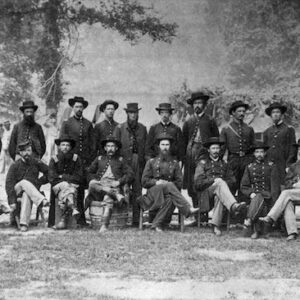Tag: Fort Harker (Nashville TN)
Fortwiki says: Fort Negley (1) (1863-1867) – A Union U.S. Civil War Fort first established in 1863 on St. Cloud Hill in Nashville, Davidson County, Tennessee. Named Fort Negley after General James S. Negley. Renamed Fort Harker after Brigadier General Charles G. Harker, who was killed 27 Jun 1864 in the battle of Kenesaw Mountain. The fort was abandoned by Union troops in 1867 after the end of the war and after Tennessee had returned to the Union.
The beginning of the U.S. Civil War found Nashville under Confederate control with Fort Henry and Fort Donelson providing external protection. With the loss of Fort Henry (6 Feb 1862) and Fort Donelson (16 Feb 1862) the Confederate position in Nashville became untenable and they surrendered the city on 25 Feb 1862.
Union forces occupied the city and turned Nashville into a Union logistics hub for the region. Work on the fortifications for the city began in August 1862 using large numbers of conscripted contrabands (runaway slaves) and free Blacks.
Brigadier General James St. Clair Morton, designed the fort and supervised its construction.
An inspection report dated 25 May 1865 by Brigadier General Zealous B. Tower, Inspector General of Fortifications, Military Division of the Mississippi, included the following: “This large work was nearly completed by General Morton, assisted by Captain Burroughs, Corps of Engineers. It is a complex fort. Within stands a square stockade twelve feet high, with flanking projections on each face. It is surrounded by a redoubt essentially square, with redan projections on the east and west sides.
Its parapets are heavy, and the scarps were walled with dry stone, over which, however, the earth of the embankment falls, so as to give a continuous slope.
On the south are two bastions, the flanks of which join to the south face of the main work, as a curtain, thus forming a bastion front. Each bastion has two interior intrenchments rising in stages, which are themselves small bastion fronts, the bastions being small bombproofs loop-holed, flanking the interior ditch, and with infantry and artillery fire to the exterior. These small bomb-proofs are surrounded nearly to the height of the loop-holes by a parapet with low, dry stone scarps.
Immediately below the main parapet to the east and west, are outer parapets about nine feet thick, apparently for infantry, with sharp salients and dry stone scarps. They connect on the north side with the main work and on the south with the bastion front.
Near the entrance in one of the salients is a bomb-proof, loopholed, which flanks the gateway front, serves as a guard.house, and as a keep to the east star-shaped outwork. The main work connects with each of the outworks by two open passages without gates, wide enough for artillery. Within this work are two casemates of timber, covered on the slope toward the enemy with railroad iron and made bomb-proof with earth. The other guns, four in number, are en barbette. No embrasures were prepared either in the upper or lower parapets.”
The Battle of Nashville
The Battle of Nashville began on 15 Dec 1864 south of the city and away from Fort Negley. Fort Negley reportedly fired the first shot of the battle which pitted the Confederate Army of Tennessee under Lt. General John Bell Hood, against Union forces under Major General George H. Thomas. General Hood had been a student of General Thomas at the United States Military Academy, received instruction in artillery from him. The Union forces prevailed and the Confederates fell back with heavy losses. The fort was not significantly involved in the fighting.
Fort Negley was abandoned by Union troops around 1867 well after the end of the war. It was reportedly used after the troops left by the Nashville Den of the Ku Klux Klan. Former Confederate general Nathan B. Forrest officially disbanded the Klan at the fort in 1869.
Showing the single result
